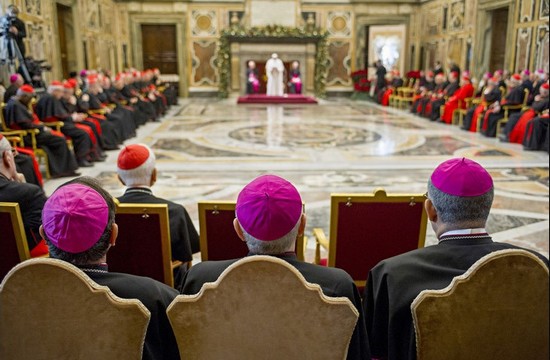Curia’s draft constitution goes to bishops’ conferences
The draft apostolic constitution governing the workings and structure of the Roman Curia is to be sent for consultation to bishops’ conferences around the world, the Vatican has announced.
Apr 19, 2019

By Nicolas Senèze
The draft apostolic constitution governing the workings and structure of the Roman Curia is to be sent for consultation to bishops’ conferences around the world, the Vatican has announced.
The April 10 announcement came at the end of a three-day meeting of the Council of Cardinals (currently the C6) that Pope Francis created in 2013 to drive his reform project.
The document will be sent “in the coming days” to the presidents of episcopal conferences, the Eastern Church Synods, Roman dicasteries and the conferences of major superiors of religious orders. It will also be sent to several pontifical universities. The purpose is “to collect their observations and views,” the Holy See statement said.
Synodality important to the pope
Although the C6 secretary Archbishop Marcello Semeraro has requested those consulted to exercise “the greatest discretion” concerning the document, members of the Council of Cardinals are under no illusions as to the risk of leaks.
“Statistically, it is highly probable that there will be leaks,” Vatican spokesperson, Alessandro Gisotti, said.
“But sending the document to the episcopal conferences comes down to synodality, which is very important to the Pope,” he added.
In this context, Gisotti emphasised that the document is not “a document from the Pope” but “a document approved by the Council of Cardinals that the Pope has authorised to be sent out for consultation.
Curia concerns
Sources said the reform has aroused great concern among those who work in the Curia.
Many of them fear that the future constitution will offer too much latitude to episcopal conferences to the detriment of the central government, resulting in a downsizing and reduced authority for the Curia.
The C6 hopes to begin studying the initial responses from episcopal conferences at its next meeting at the end of June.
Process as a concrete step in itself
The Holy See statement makes no mention of a time limit for publishing the new constitution. However, the Vatican had previously “hoped” that this would occur “before the end of the year”. It had earlier planned for its release at Easter 2019.
Nevertheless, Pope Francis has recognised that, while the process of reflection that began in 2013 may seem slow, the most important thing is that the process is fully implemented.
“In itself, the process is a concrete step forward,” Gisotti said.
The C6 also emphasised “the missionary orientation that the Curia needs to adopt, the commitment to strengthening the process of synodality in the Church and the need for a greater presence of women in leadership roles in Holy See bodies,” the spokesman said.
The role of women in the Curia is among the “new themes” that the council will add to the agenda for future reflections “with the Pope’s agreement.”
“The work of the Council of Cardinals will not end with the publication of Praedicate Evangelium,” the Vatican spokesperson said, recalling that from the beginning Pope Francis had assigned it the role of assisting him in governing the Church.
This new emphasis on the role of women was one of the themes that arose from the Synod of Bishops’ special assembly on young people. Its urgency now may underline the fact that the draft of the future constitution has failed to find a solution to the canonical obstacles that currently prevent women from gaining access to the highest Curial posts, which are usually reserved to the ordained, i.e. men. --LCI (international.la-croix.com)







Total Comments:0